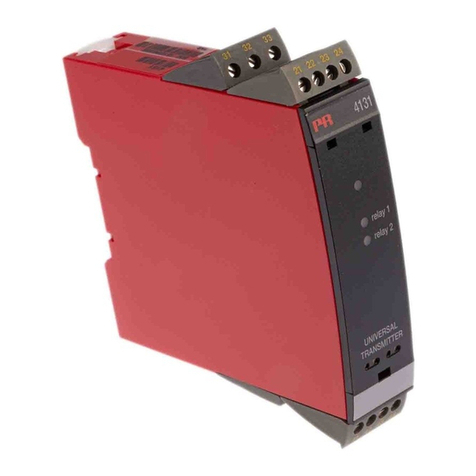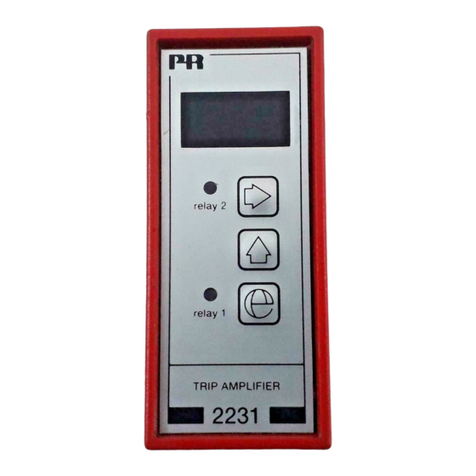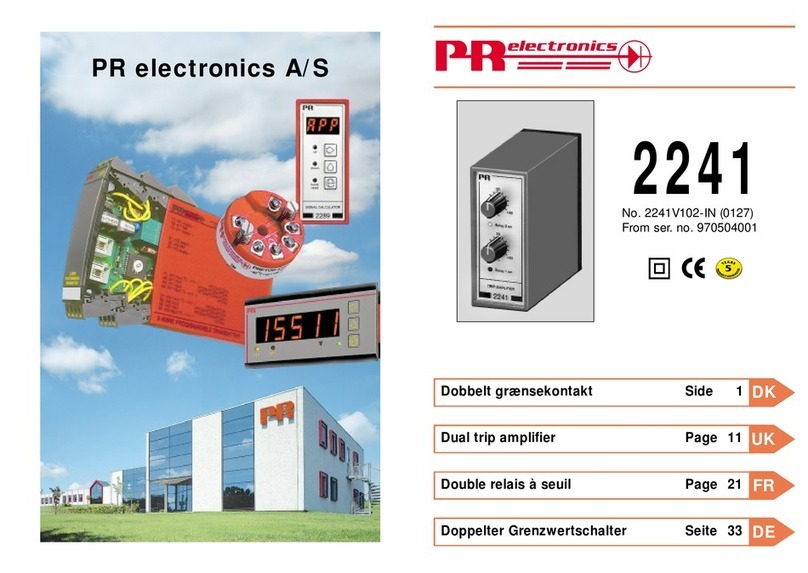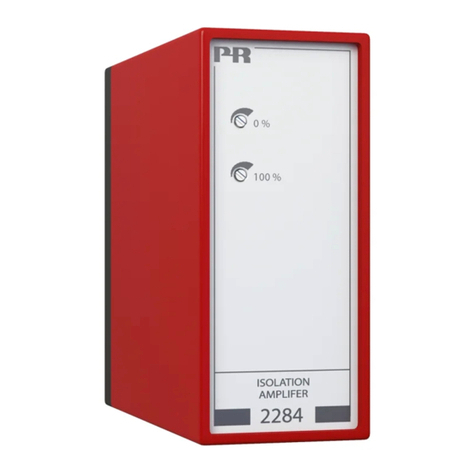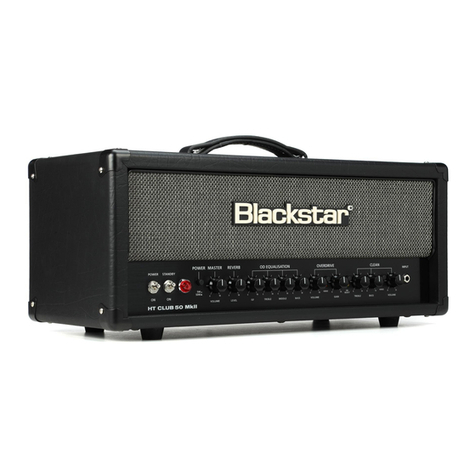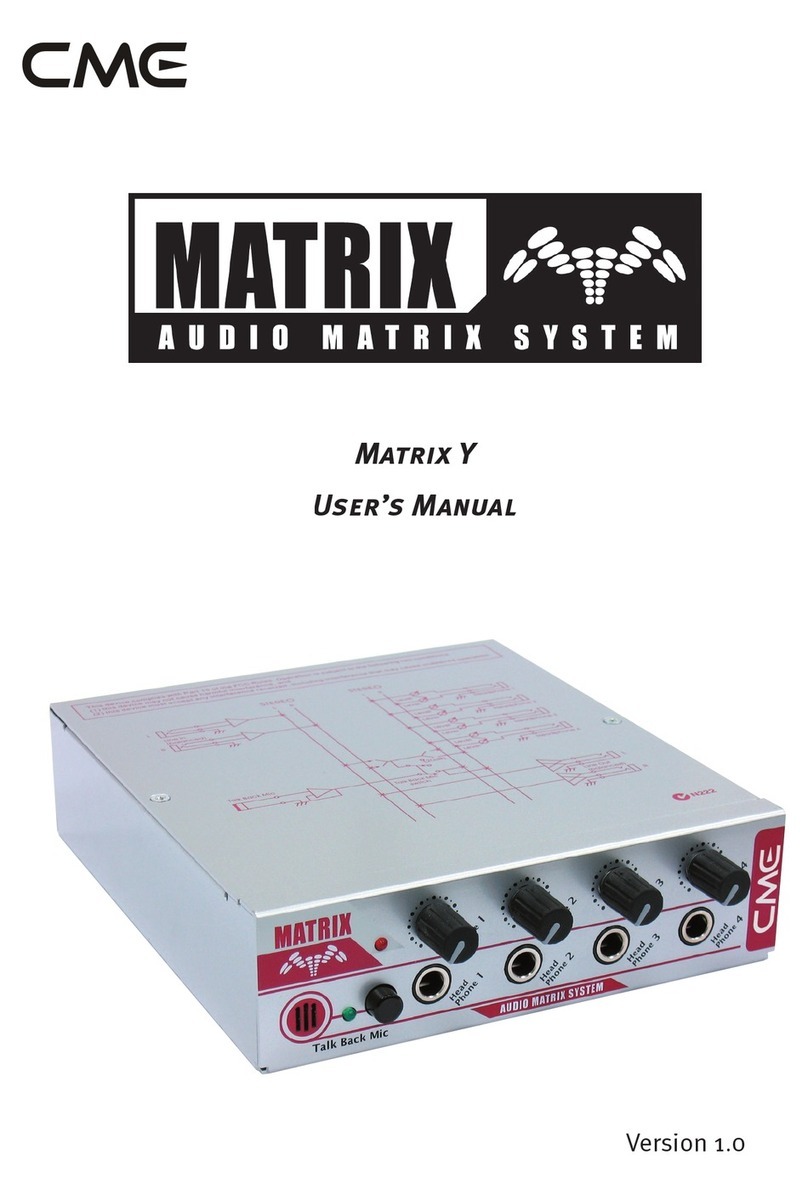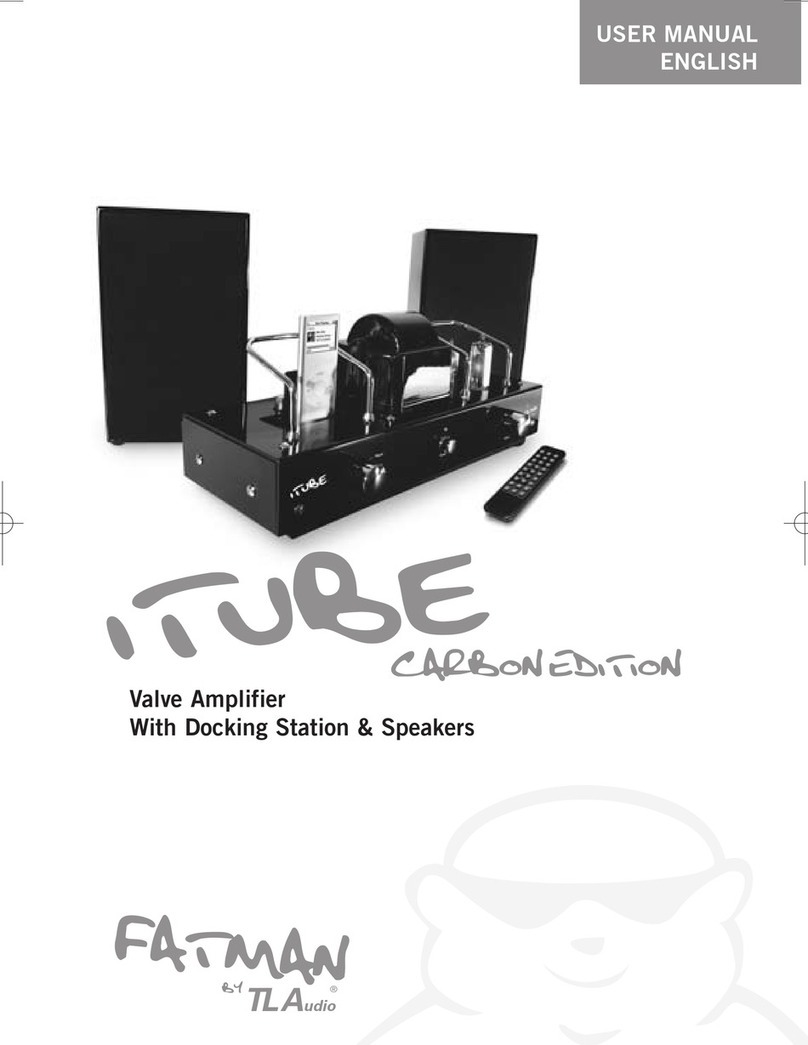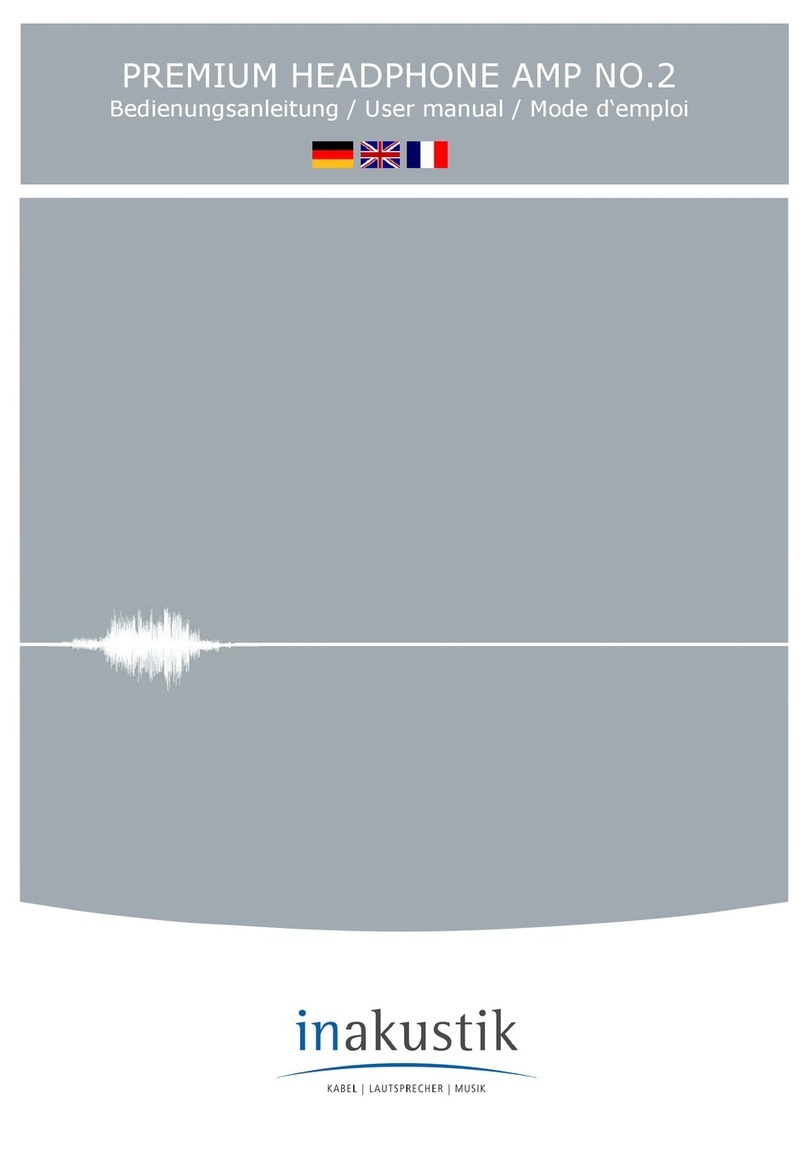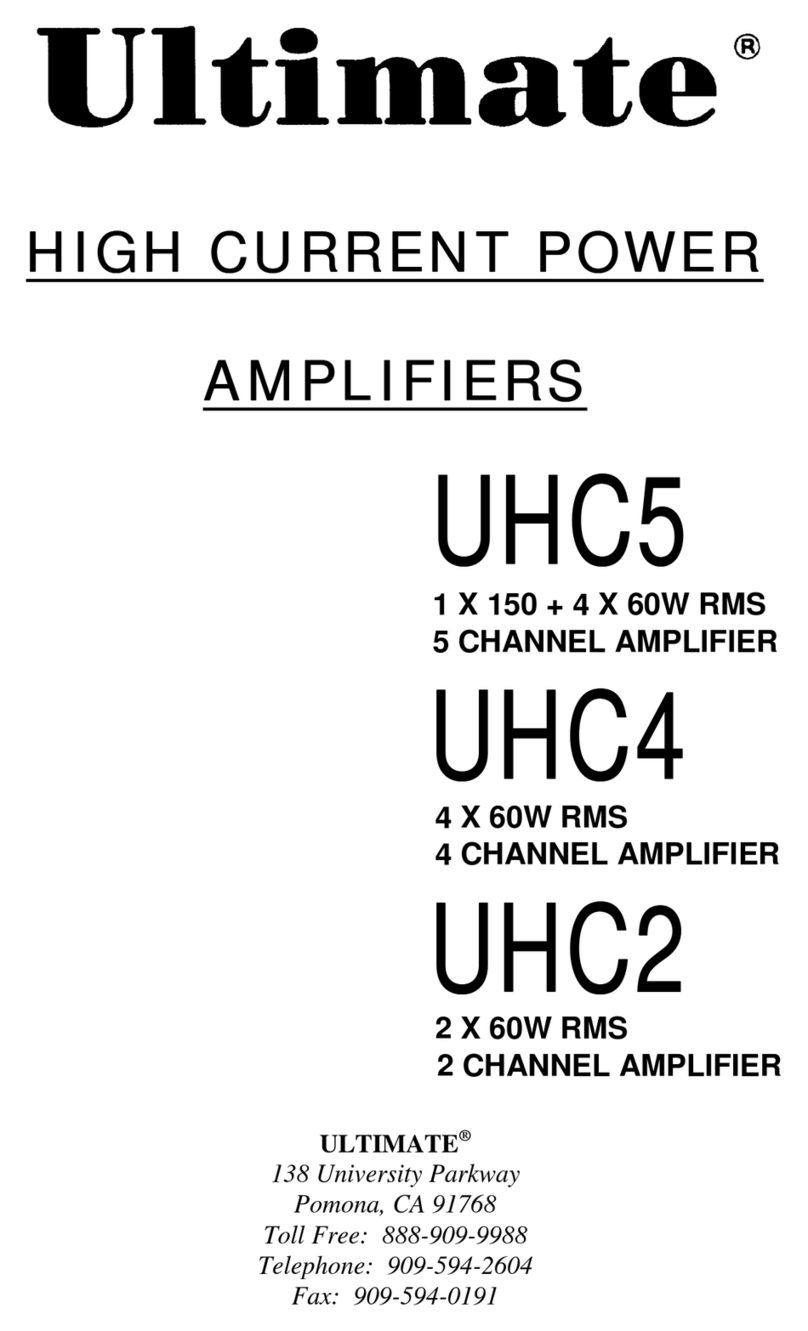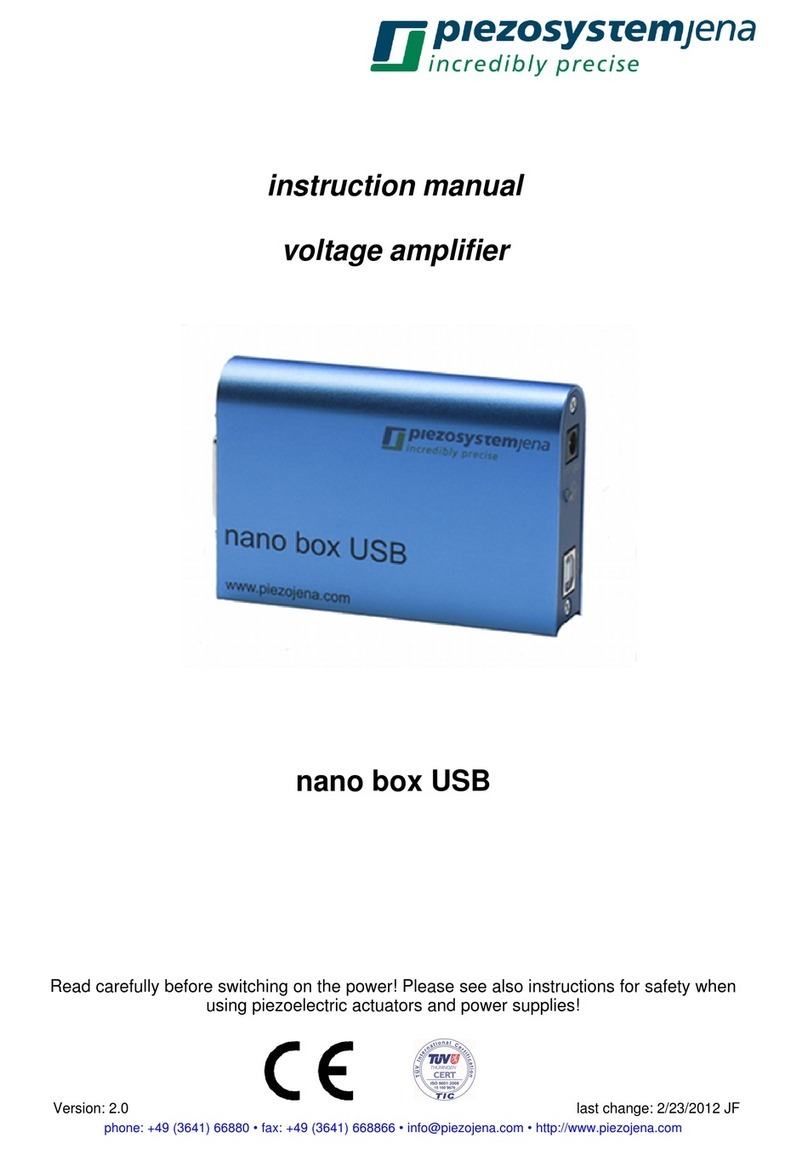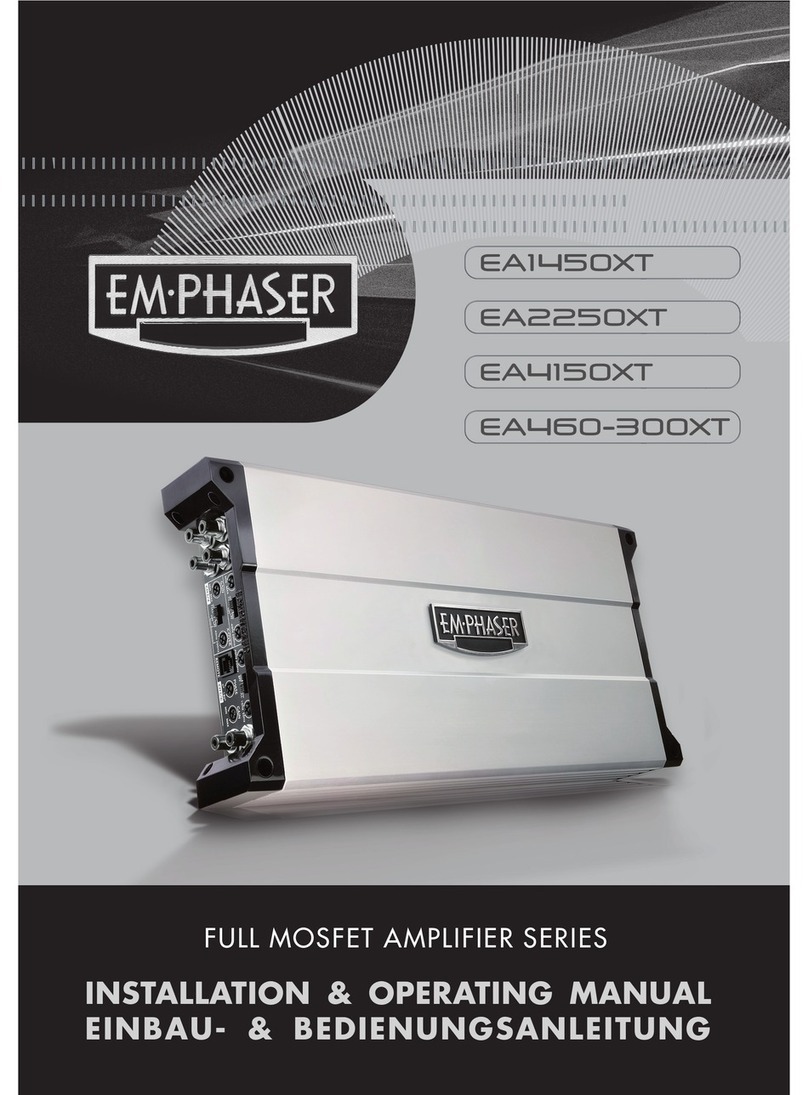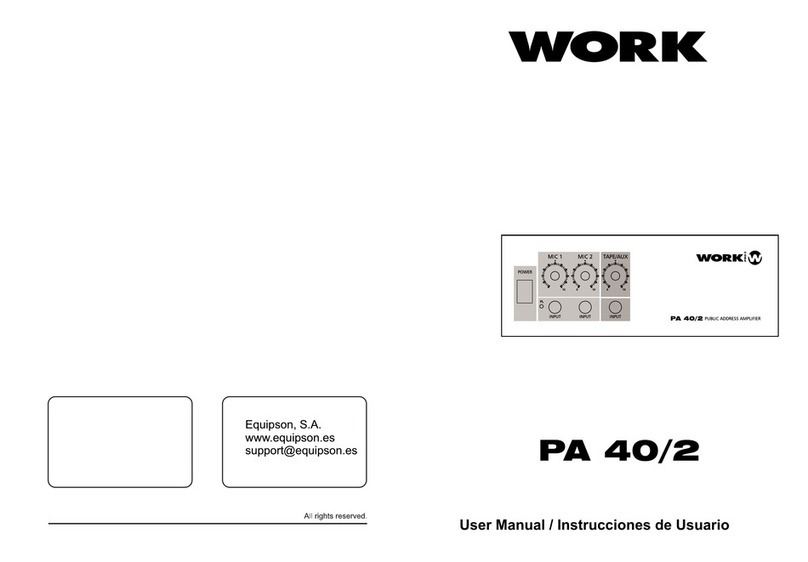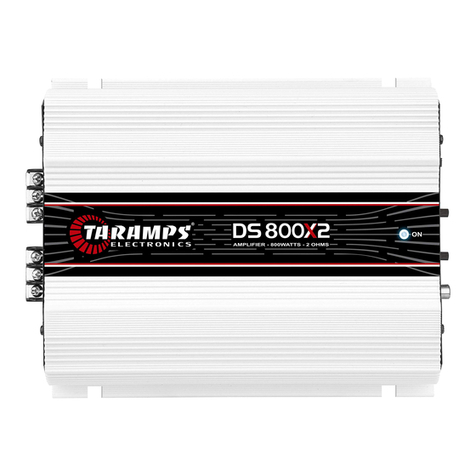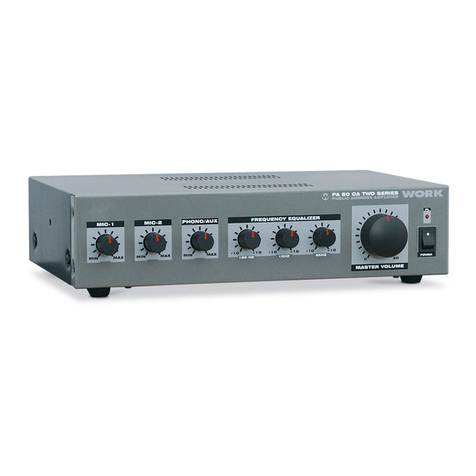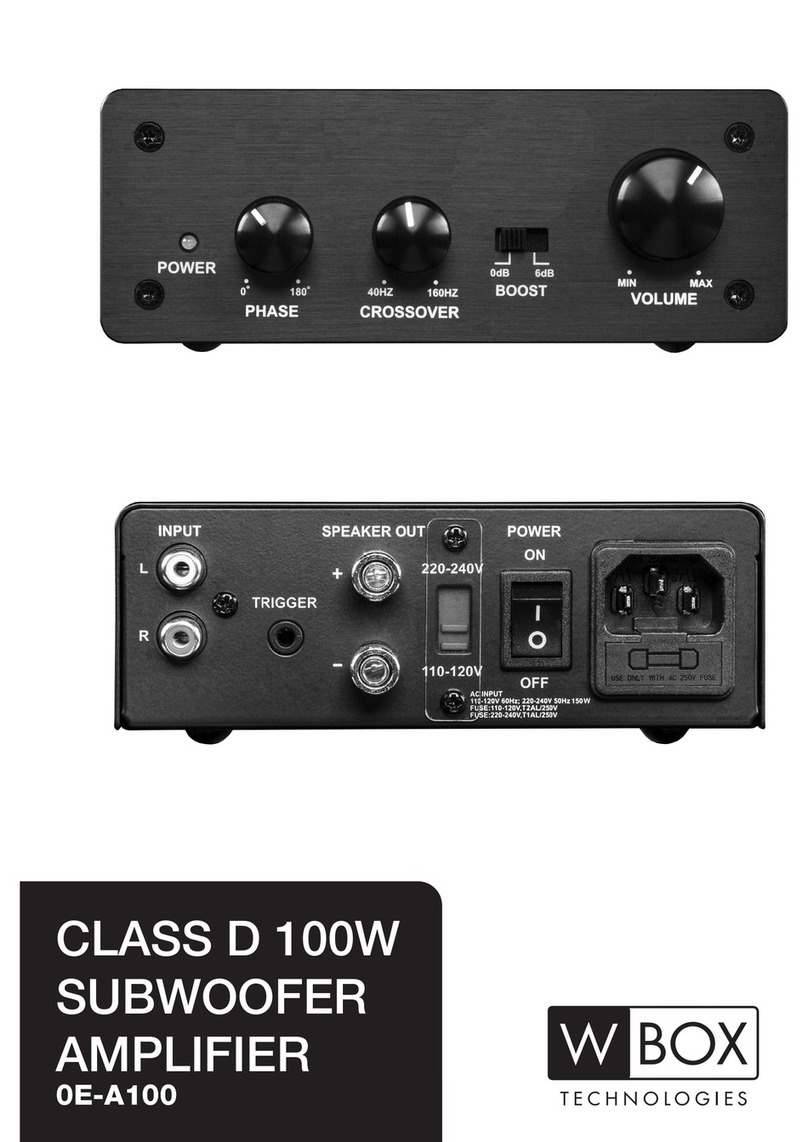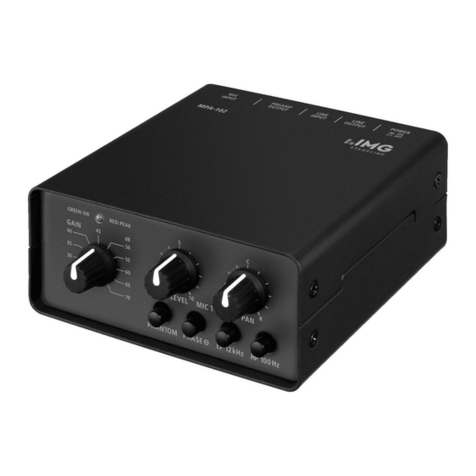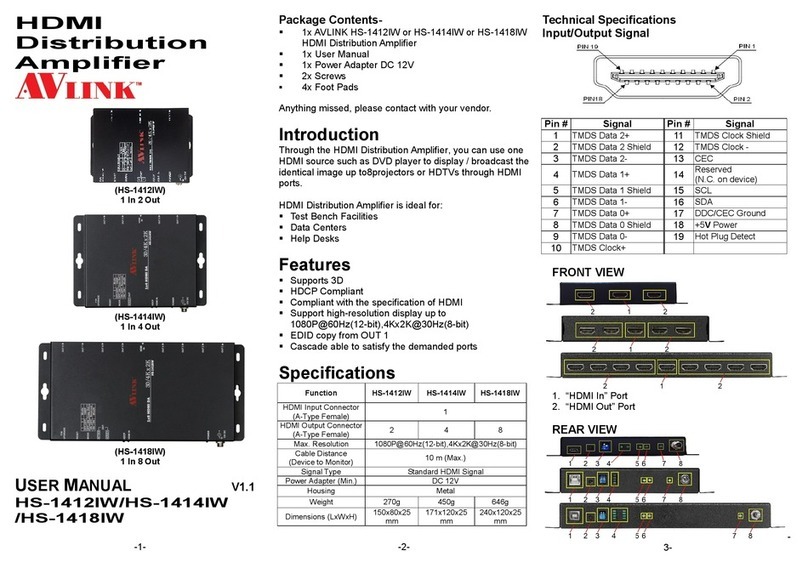PR electronics PReasy 4131 User manual

PERFORMANCE
MADE
SMARTER
Product manual
4131
Universal trip amplifier
TEMPERATURE | I.S. INTERFACES | COMMUNICATION INTERFACES | MULTIFUNCTIONAL | ISOLATION | DISPLAY
No. 4131V105-UK
Serial no.: 121524001-191041000

Communication
Display
I.S. Interface
Isolation
Multifunction
Temperature
6 Product Pillars
to meet your every need
With our innovative, patented technologies, we make signal conditioning smarter and simpler. Our portfolio is composed of six
product areas, where we offer a wide range of analog and digital devices covering over a thousand applications in industrial
and factory automation. All our products comply with or surpass the highest industry standards, ensuring reliability in even
the harshest of environments and have a 5-year warranty for greater peace of mind.
Individually outstanding, unrivalled in combination
Our range of temperature transmitters and sensors provides the highest level of signal integrity from the
measurement point to your control system. You can convert industrial process temperature signals to analog, bus or
digital communications using a highly reliable point-to-point solution with a fast response time, automatic self-
calibration, sensor error detection, low drift, and top EMC performance in any environment.
Our unique range of single devices covering multiple applications is easily deployable as your site standard. Having
one variant that applies to a broad range of applications can reduce your installation time and training, and greatly
simplify spare parts management at your facilities. Our devices are designed for long-term signal accuracy, low
power consumption, immunity to electrical noise and simple programming.
We provide inexpensive, easy-to-use, future-ready communication interfaces that can access your PR installed base
of products. All the interfaces are detachable, have a built-in display for readout of process values and diagnostics,
and can be configured via push-buttons. Product specific functionality includes communication via Modbus and
Bluetooth and remote access using our PR Process Supervisor (PPS) application, available for iOS and Android.
Our display range is characterized by its flexibility and stability. The devices meet nearly every demand for display
readout of process signals, and have universal input and power supply capabilities. They provide a real-time
measurement of your process value no matter the industry, and are engineered to provide a user-friendly and
reliable relay of information, even in demanding environments.
We deliver the safest signals by validating our products against the toughest safety standards. Through our
commitment to innovation, we have made pioneering achievements in developing I.S. interfaces with SIL 2 Full
Assessment that are both efficient and cost-effective. Our comprehensive range of analog and digital intrinsically
safe isolation barriers offers multifunctional inputs and outputs, making PR an easy-to-implement site standard.
Our backplanes further simplify large installations and provide seamless integration to standard DCS systems.
Our compact, fast, high-quality 6 mm isolators are based on microprocessor technology to provide exceptional
performance and EMC-immunity for dedicated applications at a very low total cost of ownership. They can be
stacked both vertically and horizontally with no air gap separation between units required.

4131V105-UK 3
Universal trip amplifier
4131
Table of contents
Warning ................................................................................................ 4
Symbol identification .................................................................................... 5
Safety instructions ...................................................................................... 5
How to demount system 4000 ........................................................................... 7
Application ............................................................................................. 8
Technical characteristics ................................................................................. 8
Mounting / installation / programming .................................................................... 8
Applications ............................................................................................ 9
PR 45xx display / programming front ..................................................................... 10
Mounting / demounting the PR 45xx ..................................................................... 10
Order ................................................................................................... 11
Accessories ............................................................................................. 11
Electrical specifications .................................................................................. 11
Visualisation in the 45xx of sensor error detection and input signal outside range ........................... 15
Sensor error detection limits .......................................................................... 15
Error indications...................................................................................... 16
Connections ............................................................................................ 17
Block diagram ........................................................................................... 18
Configuration / operating the function keys ............................................................... 19
Routing diagram ........................................................................................ 23
Routing diagram, advanced settings (ADV.SET) ............................................................ 26
Routing diagram, manual deactivation of the latch function ................................................ 27
Help text overview ...................................................................................... 28
Graphic depiction of latch function setpoint ............................................................... 30
Graphic depiction of latch function window................................................................ 31
Graphic depiction of relay action setpoint ................................................................. 32
Graphic depiction of relay action window.................................................................. 32
Document history ....................................................................................... 33

4 4131V105-UK
Warning
This device is designed for connection to hazardous electric voltages. Ignoring this warning can result in
severe personal injury or mechanical damage.
To avoid the risk of electric shock and fire, the safety instructions of this guide must be observed and
the guidelines followed. The specifications must not be exceeded, and the device must only be applied
as described in the following.
Prior to the commissioning of the device, this installation guide must be examined carefully.
Only qualified personnel (technicians) should install this device. If the equipment is used in a manner not
specified by the manufacturer, the protection provided by the equipment may be impaired.
Warning
Until the device is fixed, do not connect hazardous voltages to the device. The following operations
should only be carried out on a disconnected device and under ESD safe conditions:
General mounting, connection and disconnection of wires.
Troubleshooting the device.
Repair of the device and replacement of circuit breakers must be done by PR electronics A/S only.
Warning
To keep the safety distances, the relay contacts on the device must not be connected to both hazardous
and non-hazardous voltages at the same time.
Warning
Do not open the front plate of the device as this will cause damage to the connector for the display /
programming front PR 45xx.
This device contains no DIP-switches or jumpers.
SYSTEM 4000 must be mounted on a DIN rail according to DIN EN 60715.
GENERAL
HAZARD-
OUS
VOLTAGE
CAUTION
INSTAL-
LATION

4131V105-UK 5
Symbol identification
Triangle with an exclamation mark: Warning / demand. Potentially lethal situations. Read the manual
before installation and commissioning of the device in order to avoid incidents that could lead to
personal injury or mechanical damage.
The CE mark proves the compliance of the device with the essential requirements of the directives.
The double insulation symbol shows that the device is protected by double or reinforced insulation.
Safety instructions
Definitions
Hazardous voltages have been defined as the ranges: 75 to 1500 Volt DC, and 50 to 1000 Volt AC.
Technicians are qualified persons educated or trained to mount, operate, and also trouble-shoot technically correct and in
accordance with safety regulations.
Operators, being familiar with the contents of this manual, adjust and operate the knobs or potentiometers during normal
operation.
Receipt and unpacking
Unpack the device without damaging it and check whether the device type corresponds to the one ordered. The packing
should always follow the device until this has been permanently mounted.
Environment
Avoid direct sun light, dust, high temperatures, mechanical vibrations and shock, and rain and heavy moisture. If necessary,
heating in excess of the stated limits for ambient temperatures should be avoided by way of ventilation.
The device must be installed in pollution degree 2 or better.
Mounting
Only technicians who are familiar with the technical terms, warnings, and instructions in the manual and who are able to
follow these, should connect the device. Should there be any doubt as to the correct handling of the device, please contact
your local distributor or, alternatively,
PR electronics A/S
www.prelectronics.com
Mounting and connection of the device should comply with national legislation for mounting of electric materials, i.e. wire
cross section, protective fuse, and location.
Descriptions of input / output and supply connections are shown in the block diagram and side label.
The following apply to fixed hazardous voltages-connected devices:
The max. size of the protective fuse is 10 A and, together with a power switch, it should be easily accessible and
close to the device. The power switch should be marked with a label indicating that it will switch off the voltage
to the device.
Year of manufacture can be taken from the first two digits in the serial number.
UL installation requirements
Use 60/75°C copper conducters only
For use only in pollution degree 2 or better
Max. ambient temperature . . . . . . . . . . . . . . . . . . . . . . . . . . . . . . 60°C
Max. wire size. . . . . . . . . . . . . . . . . . . . . . . . . . . . . . . . . . . . . . AWG 26-14
UL file number . . . . . . . . . . . . . . . . . . . . . . . . . . . . . . . . . . . . . E231911
Calibration and adjustment
During calibration and adjustment, the measuring and connection of external voltages must be carried out according to the
specifications of this manual. The technician must use tools and instruments that are safe to use.

6 4131V105-UK
Normal operation
Operators are only allowed to adjust and operate devices that are safely fixed in panels, etc., thus avoiding the danger of
personal injury and damage. This means there is no electrical shock hazard, and the device is easily accessible.
Cleaning
When disconnected, the device may be cleaned with a cloth moistened with distilled water.
Liability
To the extent the instructions in this manual are not strictly observed, the customer cannot advance a demand against PR
electronics A/S that would otherwise exist according to the concluded sales agreement.

4131V105-UK 7
How to demount system 4000
First, remember to demount the connectors with hazardous voltages.
Picture 1:
The device is detached from the DIN rail by moving the
bottom lock down.

8 4131V105-UK
Universal trip amplifier
4131
• Input for RTD, TC, Ohm, potentiometer, mA and V
• 2 adjustable alarm limits
• FM-approved for installation in Div. 2
• 2 relay outputs
• Universal AC or DC supply
Application
• Process control with 2 pairs of potential-free relay contacts which can be configured to suit any application.
• Trip amplifier with window fonction allowing the relay to change state within a high and a low setpoint on the input span.
• Relay latch function, where the relay is activated and can only be reset manually.
• Sophisticated sensor error surveillance, where one relay holds the state immediately prior to the sensor error, thus
allowing the process to continue. The other relay can be set for sensor error alarm so that the defect sensor can be
replaced immediately.
Technical characteristics
• When 4131 is used in combination with the 45xx display / programming units, all operational parameters can be modified
to suit any application. As the 4131 is designed with electronic hardware switches, it is not necessary to open the device
for setting of DIP-switches.
• A green front LED indicates normal operation and malfunction. A yellow LED is ON for each active output relay.
• Continuous check of vital stored data for safety reasons.
• 3-port 2.3 kVAC galvanic isolation.
Mounting / installation / programming
• Very low power consumption means units can be mounted side by side without an air gap – even at 60°C ambient
temperature.
• Configuration, monitoring, 2-point process calibration and more are accomplished using PR's 45xx detachable displays.
• All programming can be password-protected.

OK
4501
1
3
4
23
4
10 4131V105-UK
PR 45xx display / programming front
Functionality
The simple and easily understandable menu structure and the explanatory help texts guide you
effortlessly and automatically through the configuration steps, thus making the product very easy to
use. Functions and configuration options are described in the section ”Configuration / operating the
function keys”.
Application
• Communications interface for modification of operational parameters in 4131.
• Can be moved from one 4131 device to another and download the configuration of the first unit to
subsequent units.
• Fixed display for readout of process data and status.
Technical characteristics
• LCD display with 4 lines:
Line 1 (H=5.57 mm) shows the input signal.
Line 2 (H=3.33 mm) shows the selected engineering unit.
Line 3 (H=3.33 mm) shows TAG no.
Line 4 shows status for communication and relays.
• Programming access can be blocked by assigning a password. The password is saved in the device
in order to ensure a high degree of protection against unauthorized modifications to the
configuration.
Mounting / demounting the PR 45xx
1: Insert the tabs of the PR 45xx into the holes at the top of the device.
2: Hinge the PR 45xx down until it snaps into place.
Demounting of the PR 45xx
3: Push the release button on the bottom of the PR 45xx and hinge the the PR 45xx out and up.
4: With the PR 45xx hinged up, remove from holes at the top of the device.

4131V105-UK 11
Order
4131 = Universal trip amplifiers
Accessories
4501 = Display / programming front
4511 = Modbus communication enabler
4512 = Bluetooth communication enabler
5910 = CJC connector
Electrical specifications
Environmental conditions
Operating temperature . . . . . . . . . . . . . . . . . . . . . . . . . . . . . . . . -20°C to +60°C
Storage temperature . . . . . . . . . . . . . . . . . . . . . . . . . . . . . . . . . -20°C to +85°C
Calibration temperature. . . . . . . . . . . . . . . . . . . . . . . . . . . . . . . . 20...28°C
Relative humidity . . . . . . . . . . . . . . . . . . . . . . . . . . . . . . . . . . . < 95% RH (non-cond.)
Protection degree . . . . . . . . . . . . . . . . . . . . . . . . . . . . . . . . . . . IP20
Installation in pollution degree 2 & measurement / overvoltage category II.
Mechanical specifications
Dimensions (HxWxD) . . . . . . . . . . . . . . . . . . . . . . . . . . . . . . . . . 109 x 23.5 x 104 mm
Dimensions (HxWxD) w/ 4501 / 451x . . . . . . . . . . . . . . . . . . . . . . . 109 x 23.5 x 116 / 131 mm
Weight approx. . . . . . . . . . . . . . . . . . . . . . . . . . . . . . . . . . . . . . 170 g
Weight incl. 4501 / 451x (approx.) . . . . . . . . . . . . . . . . . . . . . . . . . 185 g / 200 g
DIN rail type. . . . . . . . . . . . . . . . . . . . . . . . . . . . . . . . . . . . . . . DIN EN 60715 - 35 mm
Wire size . . . . . . . . . . . . . . . . . . . . . . . . . . . . . . . . . . . . . . . . . 0.13...2.08 mm2/ AWG 26...14 stranded wire
Screw terminal torque. . . . . . . . . . . . . . . . . . . . . . . . . . . . . . . . . 0.5 Nm
Vibration. . . . . . . . . . . . . . . . . . . . . . . . . . . . . . . . . . . . . . . . . IEC 60068-2-6
2...13.2 Hz . . . . . . . . . . . . . . . . . . . . . . . . . . . . . . . . . . . . . . ±1 mm
13.2...100 Hz . . . . . . . . . . . . . . . . . . . . . . . . . . . . . . . . . . . . . ±0.7 g
Common electrical specifications
Supply voltage, universal . . . . . . . . . . . . . . . . . . . . . . . . . . . . . . . 21.6...253 VAC, 50...60 Hz
or 19.2...300 VDC
Fuse . . . . . . . . . . . . . . . . . . . . . . . . . . . . . . . . . . . . . . . . . . . 400 mA SB / 250 VAC
Max. required power. . . . . . . . . . . . . . . . . . . . . . . . . . . . . . . . . . ≤ 2.0 W
Max. power dissipation . . . . . . . . . . . . . . . . . . . . . . . . . . . . . . . . ≤ 2.0 W
Isolation voltage - test . . . . . . . . . . . . . . . . . . . . . . . . . . . . . . . . 2.3 kVAC
Isolation voltage - working . . . . . . . . . . . . . . . . . . . . . . . . . . . . . . 250 VAC (reinforced) / 500 VAC (basic)
Programming . . . . . . . . . . . . . . . . . . . . . . . . . . . . . . . . . . . . . . PR 45xx
Signal dynamics, input . . . . . . . . . . . . . . . . . . . . . . . . . . . . . . . . 24 bit
Signal / noise ratio . . . . . . . . . . . . . . . . . . . . . . . . . . . . . . . . . . . > 60 dB (0...100 kHz)
Response time (0...90%, 100...10%):
Temperature input. . . . . . . . . . . . . . . . . . . . . . . . . . . . . . . . . . ≤ 1 s
mA / V input . . . . . . . . . . . . . . . . . . . . . . . . . . . . . . . . . . . . . ≤ 400 ms
Auxiliary supplies
2-wire supply (terminal 44...43) . . . . . . . . . . . . . . . . . . . . . . . . . . . 25...16 VDC / 0...20 mA

12 4131V105-UK
Accuracy, the greater of general and basic values:
Input specifications
RTD, linear resistance and potentiometer input
Input for RTD types:
Pt10, Pt20, Pt50, Pt100, Pt200, PT250, Pt300, Pt400, Pt500, Pt1000
Ni50, Ni100, Ni120, Ni1000, Cu10, Cu20, Cu50, Cu100
Input type Min.
value
Max.
value Standard
Pt10...Pt1000
Ni50...Ni1000
Cu10...Cu100
Lin. R
Potentiometer
-200°C
-60°C
-200°C
0 Ω
10 Ω
+850°C
+250°C
+260°C
10000 Ω
100 kΩ
IEC 60751
DIN 43760
α= 0.00427
-
-
Cable resistance per wire (max.), RTD . . . . . . . . . . . . . . . . . . . . . . . 50 Ω
Sensor current, RTD . . . . . . . . . . . . . . . . . . . . . . . . . . . . . . . . . . Nom. 0.2 mA
Eect of sensor cable resistance (3- / 4-wire), RTD . . . . . . . . . . . . . . . < 0.002 Ω / Ω
Sensor error detection, RTD . . . . . . . . . . . . . . . . . . . . . . . . . . . . . Yes
Short circuit detection, RTD . . . . . . . . . . . . . . . . . . . . . . . . . . . . . < 15 Ω
EMC - immunity influence. . . . . . . . . . . . . . . . . . . . . . . . . . < ±0.5% of span
Extended EMC immunity:
NAMUR NE 21, A criterion, burst . . . . . . . . . . . . . . . . . . . . . < ±1% of span
General values
Input type Absolute accuracy Temperature coecient
All ≤ ±0.1% of span ≤ ±0.01% of span / °C
Basic values
Type Basic accuracy Temperature coecient
mA ≤±4 µA ≤±0.4 µA / °C
Volt ≤±20 µV ≤±2 µV / °C
Pt100 ≤±0.2°C ≤±0.01°C / °C
Linear resistance ≤±0.1 Ω ≤ ±0.01 Ω/ °C
Potentiometer ≤±0.1 Ω ≤ ±0.01 Ω/ °C
TC type:
E, J, K, L, N, T, U
≤±1°C
≤±0.05°C / °C
TC type: R, S, W3,
W5, LR
≤±2°C
≤±0.2°C / °C
TC type: B
85...200°C
≤±4°C
≤±0.4°C / °C
TC type: B
200...1820°C
≤±2°C
≤±0.2°C / °C

4131V105-UK 13
TC input
Type Min.
value
Max.
value Standard
B
E
J
K
L
N
R
S
T
U
W3
W5
LR
0°C
-100°C
-100°C
-180°C
-200°C
-180°C
-50°C
-50°C
-200°C
-200°C
0°C
0°C
-200°C
+1820°C
+1000°C
+1200°C
+1372°C
+900°C
+1300°C
+1760°C
+1760°C
+400°C
+600°C
+2300°C
+2300°C
+800°C
IEC 60584-1
IEC 60584-1
IEC 60584-1
IEC 60584-1
DIN 43710
IEC 60584-1
IEC 60584-1
IEC 60584-1
IEC 60584-1
DIN 43710
ASTM E988-90
ASTM E988-90
GOST 3044-84
Cold junction compensation (CJC):
via external sensor in connector 5910. . . . . . . . . . . . . . . . . . . . . . 20...28°C ≤ ±1°C
-20...20°C / 28...70°C ≤±2°C
via internal CJC sensor . . . . . . . . . . . . . . . . . . . . . . . . . . . . . . . ±(2.0°C + 0.4°C * Δt)
Δt = internal temperature - ambient temperature
Sensor error detection, all TC types. . . . . . . . . . . . . . . . . . . . . . . . . Yes
Sensor error current:
when detecting . . . . . . . . . . . . . . . . . . . . . . . . . . . . . . . . . . . Nom. 2 μA
else. . . . . . . . . . . . . . . . . . . . . . . . . . . . . . . . . . . . . . . . . . . 0 μA
Current input
Measurement range . . . . . . . . . . . . . . . . . . . . . . . . . . . . . . . . . . 0...23 mA
Programmable measurement ranges . . . . . . . . . . . . . . . . . . . . . . . . 0...20 and 4...20 mA
Input resistance . . . . . . . . . . . . . . . . . . . . . . . . . . . . . . . . . . . . Nom. 20 Ω + PTC 50 Ω
Sensor error detection:
Loop break 4...20 mA . . . . . . . . . . . . . . . . . . . . . . . . . . . . . . . . Yes
Voltage input
Measurement range . . . . . . . . . . . . . . . . . . . . . . . . . . . . . . . . . . 0...12 VDC
Programmable measurement ranges . . . . . . . . . . . . . . . . . . . . . . . . 0...1 / 0.2...1 / 0...5 / 1...5 / 0...10 and 2...10 VDC
Input resistance, nom.. . . . . . . . . . . . . . . . . . . . . . . . . . . . . . . . . 10 MΩ
of span = of the currently selected measurement range
Output specifications
Relay outputs
Relay functions. . . . . . . . . . . . . . . . . . . . . . . . . . . . . . . . . . . . . Setpoint, Window, Sensor error, Latch, Power and O
Hysteresis. . . . . . . . . . . . . . . . . . . . . . . . . . . . . . . . . . . . . . . . 0...100%
On and O delay . . . . . . . . . . . . . . . . . . . . . . . . . . . . . . . . . . . . 0...3600 s
Sensor error detection . . . . . . . . . . . . . . . . . . . . . . . . . . . . . . . . Break / Make / Hold
Max. voltage . . . . . . . . . . . . . . . . . . . . . . . . . . . . . . . . . . . . . . 250 VAC / VDC
Max. AC current. . . . . . . . . . . . . . . . . . . . . . . . . . . . . . . . . . . . . 2 A
Max. AC power . . . . . . . . . . . . . . . . . . . . . . . . . . . . . . . . . . . . . 500 VA
Max. DC current, resistive load:
@ Urelay ≤ 30 VDC . . . . . . . . . . . . . . . . . . . . . . . . . . . . . . . . . . 2 ADC
@ Urelay >30 VDC. . . . . . . . . . . . . . . . . . . . . . . . . . . . . . . . . . . [1380 x U-2
relay x 1.0085Urelay] ADC

0,10 A
1,00 A
0 V 50 V 100 V 150 V 200 V 250 V
CURRENT
U
RELAY
14 4131V105-UK
Graphic depiction of [1380 x U-2
relay x 1.0085Urelay]:
Observed authority requirements
EMC. . . . . . . . . . . . . . . . . . . . . . . . . . . . . . . . . . . . . . . . . . . . 2014/30/EU
LVD . . . . . . . . . . . . . . . . . . . . . . . . . . . . . . . . . . . . . . . . . . . . 2014/35/EU
RoHS . . . . . . . . . . . . . . . . . . . . . . . . . . . . . . . . . . . . . . . . . . . 2011/65/EU
EAC . . . . . . . . . . . . . . . . . . . . . . . . . . . . . . . . . . . . . . . . . . . . TR-CU 020/2011
Approvals:
c UL us, UL 508. . . . . . . . . . . . . . . . . . . . . . . . . . . . . . . . . . . . . E231911
FM . . . . . . . . . . . . . . . . . . . . . . . . . . . . . . . . . . . . . . . . . . . . 3025177
DNV-GL . . . . . . . . . . . . . . . . . . . . . . . . . . . . . . . . . . . . . . . . . TAA0000101
EU RO Mutual Recognition Type Approval . . . . . . . . . . . . . . . . . . . . . MRA000000Z
Urelay
50 V 150 V0 V 100 V 200 V 250 V
Current
0.10 A
0.40 A
0.80 A
0.20 A
1.00 A
0.60 A
2.00 A
3.00 A

4131V105-UK 15
Visualisation in the 45xx of sensor error detection and
input signal outside range
Sensor error detection limits
Display readout below min. / above max. (-1999, 9999):
Input Range Readout Limit
All All -1999 Display readout <-1999
9999 Display readout >9999
Sensor error check:
Device Configuration Sensor error detection:
4131 R1, ERR.ACT=NONE - R2, ERR.ACT=NONE OFF
Else: ON
Outside range readout (IN.LO, IN.HI):
If the valid range of the A/D converter or the polynomial is exceeded
Input Range Readout Limit
VOLT
0...1 V / 0.2...1 V IN.LO < -25 mV
IN.HI > 1.2 V
0...10 V / 2...10 V IN.LO < -25 mV
IN.HI > 12 V
CURR 0...20 mA / 4...20 mA IN.LO < -1.05 mA
IN.HI > 25.05 mA
LIN.R
0...800 Ω IN.LO < 0 Ω
IN.HI > 1075 Ω
0...10 kΩ IN.LO < 0 Ω
IN.HI < 110 kΩ
POTM -IN.LO < -0.5 %
IN.HI > 100.5 %
TEMP TC / RTD IN.LO < temperature range -2°C
IN.HI > temperature range +2°C
Sensor error detection (SE.BR, SE.SH):
Input Range Readout Limit
CURR Loop break (4..20 mA) SE.BR <= 3.6 mA; > = 21 mA
POTM All, SE.BR on all 3-wire SE.BR > ca. 126 kΩ
LIN.R 0...800 Ω SE.BR > ca. 875 Ω
0...10 kΩ SE.BR > ca. 11 kΩ
TEMP
TC SE.BR > ca. 750 kΩ / (1.25 V)
RTD, 2-, 3-, and 4-wire
No SE.SH for Cuxx, Pt10, Pt20 and Pt50
SE.BR > ca. 15 kΩ
SE.SH < ca. 15 Ω

16 4131V105-UK
Readout at hardware error
Error search Readout Cause
Test of internal CJC sensor CJ.ER CJC sensor defect or temperature outside range
Checksum test of the configuration in FLASH FL.CO Error in FLASH
Communications test 45xx / 4131 NO.CO Connection error
Check that input signal matches input
configuration IN.ER 1) Error levels on input
Check that saved configuration in 45xx matches
device TY.ER Configuration is not 4131
!
All error indications in the display flash once per second. The help text explains the error. If the error is a
sensor error, the display backlight flashes as well - this is acknowledged (stopped) by pushing the 3
button.
1) The error is reset by switching off and then switching on the supply voltage to the device.
Error indications

4131V105-UK 17
Connections
31 32 33
21 22 24
23
R1 R2
42 44
43
41 41 42 44
43
41 42 44
43 41 42 44
43
+
-
41 42 44
43 41 42 44
43
+
-
41 42 44
43
+
-Tx
41 42 44
43
+
-
41 42 44
43 41 42 44
CJC
+
-
Outputs:
Relays
TC, internal
CJC sensor Resistance, 2-wireRTD, 3- / 4-wireRTD, 2-wire
Inputs:
Supply
2-wire transmitter Current
Potentiometer
Resistance,
3- / 4-wire
*TC, CJC connectorVoltage
* Order separately:
CJC connector 5910

50.0
VALVE 5
l / min
*
4131
21
20 Ω
CPU
EEPROM
CJC
PTC
MUX A / D
44
43
42
41
0.2 mA
Vloop 31
33
22
21
23
24
24 3
+
-
+
-
+
-
18 4131V105-UK
Block diagram
Potentiometer
2-wire transmitter
Voltage
Current
RTD og lin.R,
connection,
wires
Supply
Supply
21.6...253 VAC or
19.2...300 VDC
TC
Relay 2
Relay 2
Relay 1
Relay 1
Green
Yellow
Yellow
Order separately: CJC connector 5910

4131V105-UK 19
Configuration / operating the function keys
Documentation for routing diagram.
In general
When configuring the 4131, you will be guided through all parameters and you can choose the settings which fit the
application. For each menu there is a scrolling help text which is automatically shown in line 3 on the display.
Configuration is carried out by use of the 3 function keys:
1will increase the numerical value or choose the next parameter
2will decrease the numerical value or choose the previous parameter
3will save the chosen value and proceed to the next menu
When configuration is completed, the display will return to the default state 1.0. Pressing and holding 3will return to the
previous menu or return to the default state (1.0) without saving the changed values or parameters.
If no key is activated for 1 minute, the display will return to the default state (1.0) without saving the changed values or
parameters.
Further explanations
Fast setpoint adjustment and relay test: These menus allow you to make a quick setpoint change and relay test when the
FastSet menu is activated. This function can only be activated when the relays are set for setpoint function and are controlled
by a setpoint.
Pressing 1and 2simultaneously will activate a relay test and change the state of the relay.
Pressing 3will save the setpoint change.
Holding down 3for more than 1 second will return the unit to the default state without saving the setpoint change.
Password protection: Programming access can be blocked by assigning a password. The password is saved in the device in
order to ensure a high degree of protection against unauthorized modifications to the configuration.
If the configured password is not known, please contact PR electronics support - www.prelectronics.com/contact.
Signal and sensor error info via display front 45xx
Sensor error (see limits in the table) is displayed as SE.BR (sensor break) or SE.SH (sensor short). Signals outside the selected
range (not sensor error, see table for limits) are displayed as IN.LO indicating low input signal or IN.HI indicating high input
signal. The error indication is displayed in line 3 as text and at the same time the backlight flashes. Line 4 of the display is a
status line which displays status of relay 1 and relay 2, COM (flashing bullet) indicating correct functioning of 45xx and arrow
up/down which indicates tendency readout of the input signal. If the figure 1 or figure 2 flashes, the unit has detected that
the setpoint has been exceeded and that the relay is in “delay” mode. When the delay time has passed and the relay makes /
breakes, the relay sign either displays or disappears.
Signal and sensor error indication without display front
Status of the unit can also be read from the green LED in the front of the device.
Green flashing LED 13 Hz indicates normal operation.
Green flashing LED 1 Hz indicates sensor error.
Steady green LED indicates internal error.
Relay functions
6 different settings of relay function can be selected.
Setpoint: The unit works as a single limit switch
Window: The relay has a window that is defined by a low and a high setpoint. On both sides of the window the
relay has the same status.
Error function: The relay is activated by sensor error.
Power: The relay is activated as long as the power is on.
Off: The relay is deactivated.
Latch: The relay is latched. Only valid for setpoint and window function.
Increasing/decreasing: The relays can be set to activate at increasing or decreasing input signal.
Delay: An ON and an OFF delay can be set on both relays in the range 0...3600 s.
Hysteresis: 0.0...100.0%.

20 4131V105-UK
Latch
When the setpoint is exceeded the relay outputs enters an alarm state. The latch function of the 4131 will hold the relays in
this state until the function is deactivated manually. The latch function can be applied when the relay function setpoint or
window is selected.
The latch function can be selected separately for each relay output. If the configuration is copied from one device to another
by way of the 45xx, the latch function must be reconfigured.
The latch function activates and holds the relays when the input signal rises above or falls below the selected setpoints and
the relay action has been selected as increasing or decreasing.
The window function is selected by choosing ”window” in the menu and defining a high and a low setpoint.
It can be selected for each relay contact whether the contact is open or closed inside the window. This selection is made in
the menu R1.cont and R2.cont.
The setpoint function is selected by choosing ”setpoint” in the menu and entering the desired limit. The device then works as
a single limit switch.
An activated relay means that the contact is closed if the contact function ”normally open” is selected, and the contact is open
if the contact function ”normally closed” is selected.
The delay time for activation and deactivation can be set independently of each other in the menus ON.DEL and OFF DEL
respectively.
If the relay function ”Error” is active, the relay will latch when a sensor error occurs and will not be deactivated automatically
when the sensor error is rectified.
The relay can only be deactivated by an operator and only when the normal conditions for deactivation are met. If the input
signal still has a value that will activate the relay, the relay will latch again.
See the graphic depiction of the setpoint and window functions on pages 30 and 31.
Manual deactivation of the latch function
If the relay outputs are activated and thereby latched, it will be indicated in the display. The backlight flashes and the scrolling
help text tells you how to deactivate the output. Manual deactivation is carried out by way of the front buttons on the 45x.
Use 1and 2to navigate in the menu and 3to validate your selection. If the password protection has been activated, the
password must be entered in order to access the deactivation menu. See the menu structure on page 27.
Advanced functions
The unit gives access to a number of advanced functions which can be reached by answering “Yes” to the point “ADV.SET”.
Memory (MEM): In the memory menu you can save the configuration of the device in the 45xx, and then move the 45xx onto
another device of the same type and download the configuration in the new device.
Display setup (DISP): Here you can adjust the brightness contrast and the backlight. Setup of TAG numbers with 6
alphanumerics. Line 3 of the display shows tag no.
Two-point process calibration (CAL): The device can be process-calibrated in 2 points to fit a given input signal . A low input
signal (not necessarily 0%) is applied and the actual value is entered via 45xx. Then a high signal (not necessarily 100%) is
applied and the actual value is entered via 45xx. If you accept to use the calibration, the device will work according to this
new adjustment. If you later reject this menu point or choose another type of input signal the device will return to factory
calibration.
Process simulation function (SIM): In the menu point “EN.SIM” it is possible to simulate an input signal by means of the arrow
keys and thus test the function of the relays. You must exit the menu by pressing 3(no time-out).
The following point allows you to activate relay 1 and relay 2 by means of the arrow-keys up/down. You must exit the menu
by pressing 3(no time-out).
The simulation function exits automatically, if the 45xx is detached.
Other manuals for PReasy 4131
2
Table of contents
Other PR electronics Amplifier manuals

